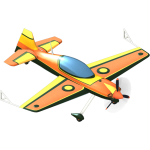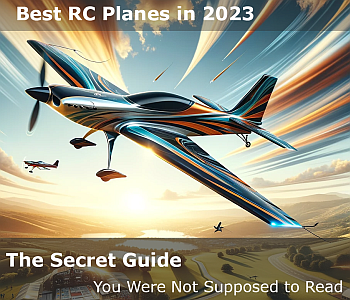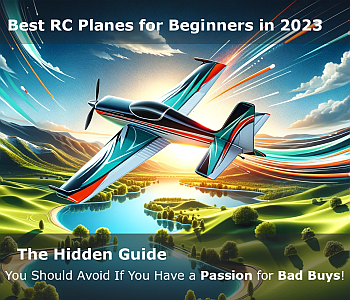Learning to fly is a journey filled with strong emotions. You bought your first RC plane, you have unboxed it, and now you want to see it in the air and do some cool stuff with it. Well, we have some tips for you that will help you have happy landings.
Airplane Terminology
Below are some terms you should know before starting to fly. Take a look at them.
- Ailerons – Rolls the plane and/or provides directional control
- Flaps – Decreases the speed of the aircraft without stalling
- Landing gear – wheels on the bottom of the plane
- Vertical fin – fin on the back of the plane
- Rudder – moveable fin on the vertical fin
- Elevator – moveable fins below the rudder
Technical Information – A load cell is typically an electronic device (transducer) that is used to convert a force into an electrical signal. The transistors are a semiconductor device, commonly used as an amplifier or an electrically controlled switch. The multimeters are electronic measuring instrument that combines several functions in one unit. The semiconductors are a solid material that has electrical conductivity in between that of a conductor and that of an insulator.
How to Fly RC Planes
- Quick Tips
- Make sure no other people operating on the same radio frequency is flying model airplanes around you
- Before you fly, make sure your airplane is properly trimmed and balanced
- Test glide airplane before you fly it
- If flying an electric airplane, make sure the battery is fully charged. If flying a gas airplane, make sure the tank is full
- Fully extend antenna before flying model airplanes
- Don’t fly near people or objects
- The Buddy System – before we begin, I thought I should tell you about the buddy system. Many first-time flyers choose to train with a buddy box. A buddy box is a device that connects the students’ and instructors’ radio transmitter, so the instructor can take over control of the airplane at any time. For example, you are flying model airplanes and all of a sudden your plane gets hit by a downwind and is starting to crash. Your instructor can take control instantly and prevent the crash.
- Before You Fly – It’s best to start with an aircraft that’s designed specifically for beginners. Look for one that has 1 or 2 channels (in some cases 3 channels are OK, but never more than 3; and many 3 channel craft are just too complicated for someone who is just getting started and doesn’t have any help). Some models have the option to upgrade later – to add another channel or maybe to switch from beginner to expert mode – as your flying skills improve.
- Pre Flight Checklist – before you start flying model airplanes, make sure …
- control surfaces have free movement
- all screws, bolts, etc. are tight
- radio equipment is securely fastened inside the fuselage
- receiver is receiving transmitter commands
- fuel tubing is free of kinks
- batteries are fully charged
- airplane is properly fueled
- no wires interfere with servo motors
- antenna is properly strung
- servos respond correctly to control inputs
- wings are securely fastened
- rudder moves in the correct direction
- on and off works for engine
*Some items on the checklist are for flying model airplanes that are gas-powered only.
- Taxi Tests – now that you are ready to start flying model airplanes, you need to practice taxing. Start your RC airplane up, and then slowly taxi your plane up and down the runway. Get the feel for controlling your model plane this way. Taxing is also a great way for you to learn reverse steering. See, when your RC model airplane is flying towards you, left and right are reversed. So when you are taxing your plane, have the plane come towards you and practice your reverse steering.
- Taking Off – taking off is a lot easier than you would think. In fact, most RC planes will slowly takeoff by there selves if you just apply full throttle. You will still have to maintain heading and pitch, though.
Okay, before you try to take off, remember that it is easier to take off into the wind, not downwind. So with that in mind, get your radio-controlled plane in the right direction and slowly give your engine full power. When your plane starts heading down the runway, you will notice it wants to pull to the left a little. To correct this, move the rudder a little to the right.
When the airplane starts to get light on the wheels, pull back on the elevator stick and let the nose rise. Keep the wings level, and fly the model at about a 20 to 25 degrees angle to the ground. If the model starts to climb at to steep of an angle, just ease off the elevator stick. Once the model is at 125 feet, it is time to turn it around.
- Turning your Airplane – once your plane is finally in the air and flying, you need to learn how to turn. As you probably already know, ailerons (flaps) make an airplane turn and roll. So, to start off with applying left or right ailerons and make the plane turn about 20 degrees from level, then add up the elevator to bring the model around.
To increase or decrease the radius of the turn, add more or less elevator. As you increase ailerons and elevators, you must also increase the throttle slightly.
When the plane is on the heading you want, release up on the elevator, and apply a little opposite aileron to make the plane level. Then bring the throttle back to the desired speed to resume level flight. Now that the airplane is turned towards your left and right are now the opposite.
So, when you want the plane to go to your left, turn it right. A simple way to guide your model when it is flying towards you is to move the aileron stick in the direction of the lower wing panel on the airplane.
- Leveling your Airplane – sometime,s it can be very difficult flying model airplanes when it is at a high altitude and/or far away. If that occurs, the best thing to do is to follow the flight path of your plane. You must be able to turn left and right and maintain a constant altitude before you can start landing. If you want to raise your plane when it is flying towards you, and controls are reversed, move your aileron stick away from the direction of your lower wing.
- Setting Up for the Landing – The four basic parts of the landing pattern are:
- downwind leg
- base leg
- final approach
- flare
You always want to land with the nose into the wind to keep the airspeed of the plane as high as possible while minimizing its ground speed. When the plane is at the far side of the runway and in front of you, pull the throttle back to about half, and pull back on the elevator stick a little to slow the model down. Remember, throttle controls descent and the elevator controls airspeed. Don’t stall model by pulling all the way back on the elevator.
Just before your plane touches the ground, flare the nose up gradually and let it gently glide down. This will eliminate excess speed and prevents the model airplane from bouncing back into the air. Now that the model is on the runway, just keep on the rudder and let the model go straight ahead until it comes to a stop. That’s it!! Not so hard huh. Now that you have made your perfect landing, you can spend the rest of your life perfecting your craft. Over time, you will be able to land with ease.
- Landing – landing your plane is a very important part of flying model airplanes. In fact, it’s the most important thing to be good at if you want to fly your airplane more than once! The best way to get good at landing your plane is to practice.
Before you try to land, make sure you are at a safe altitude and at a low throttle setting. If you don’t slow your model down, you will not make a successful landing. Next, you want to bring the throttle back and pull the nose up slightly to prevent your RC airplane from descending.
The primary factor in landing is your throttle. You want to have the throttle just a little above the stall speed. Before you try to land you should practice flying model airplanes in and out of the stalled condition. When you are experimenting with your stall speeds, it could fall forward, or one of the wings will drop. Just keep at it, and you will learn how to recover.
- Hand Launching – another great way to get your model in the air is to hand launch it. This is ideal for little RC airplanes and flying fields with only grass and no runways. Electric gliders usually don’t have landing gears, so they definitely need to be hand launched. You do have to be careful, though, when hand launching airplanes with propellers.
To hand launch your plane, you need to grab hold to the center of gravity on the plane (the middle of the airplane) with one hand. With your other hand, support the nose of the model. Then hold the model overhead with the nose and wings level, and after taking a few steps, throw the plane javelin style. Do not launch it in a steep climbing altitude, as this will quickly slow it down and often leads to a stall and then a crash.
So, the proper technique is to launch the RC airplane level and pointed at or just above the horizon. You must be careful not to get struck by the tail, and stay clear of the propeller! If your RC model airplane does not have a landing gear, then your plane will land with the engine off, and it will just slowly glide down and slide on its belly. If your plane does have a landing gear, look at my landing part to land your airplane.
- Flying Clubs & Fields near You – joining a flying club is a great idea if you are really enthusiastic about flying model airplanes. In a club, you will learn much quicker, have good guidance, and usually will be able to get a flying instructor to help you. A model airplane club also has a flying field where they fly. So you won’t have to worry about where your next flight is going to be.
Training with an experienced flier can really shorten your learning curve; if you’ve already bought an aircraft, working with a seasoned pilot can help you avoid or minimize damage to your RC plane or helicopter; if you’ve not yet made that purchase, your local club may have trainer airplanes or helicopters you can use and a “buddy box” which will be covered in the next article in this series. For the location of a local RC club near you, and a directory of RC flight instructors, check out the website of the Academy of Model Aeronautics (AMA) at www.modelaircraft.org.
- RC Flight Simulators – RC flight simulators are a great way to learn how to fly model airplanes. They provide a realistic flight experience along with the tools you need to learn your basic flight maneuvers. It’s almost like the real thing, it can be done in any weather, at any time for day or night, and virtual crashes beat real ones every time.
Plus, since you are just flying model airplanes on the computer, no real damage can be done if you crash. Damages to your plane will happen—even the pros make mistakes occasionally—but a flight simulator will give you the experience you need to lessen those and so end up saving you money in the not-too-long run. RC simulators are available for either RC airplanes only or for both planes and RC helicopters and can be downloaded or purchased as kits. For learning the basics of radio control aviation, simulators are the next best thing to the flying field and will allow you to continue to sharpen your skills, even past the beginner stage.
- Don’t get discouraged. Keep trying. If you’re like me, the first 10 to 20 times you try to fly your craft, you’ll wonder if you’ll ever get the hang of even the most simple and basic things. It really will get easier – and easier – and more and more fun! I never played video games much and had never flown a real aircraft. People who have played a lot of video games often pick up the basic RC flying skills more quickly than those who haven’t. Flying RC improves hand-to-eye coordination and mental focus.
guest post by John Red




